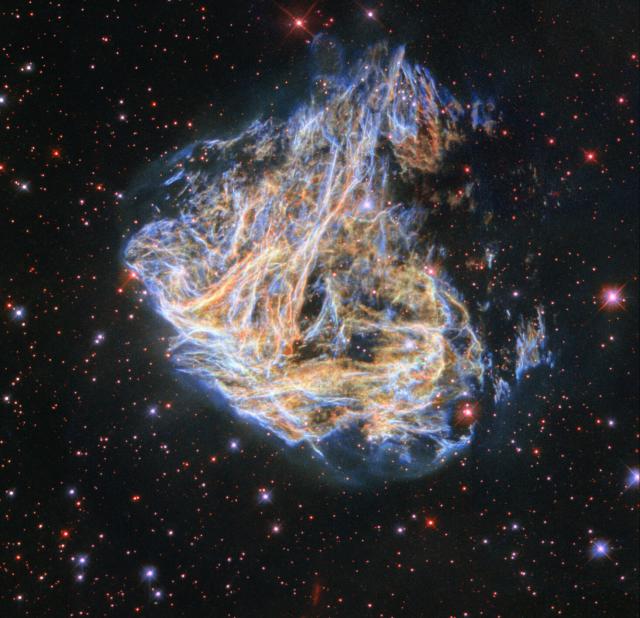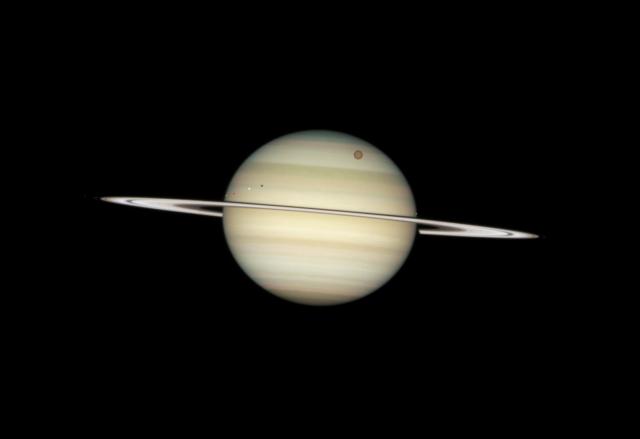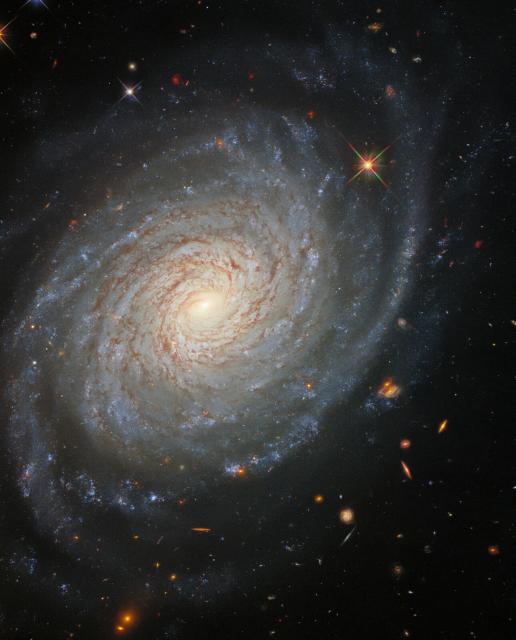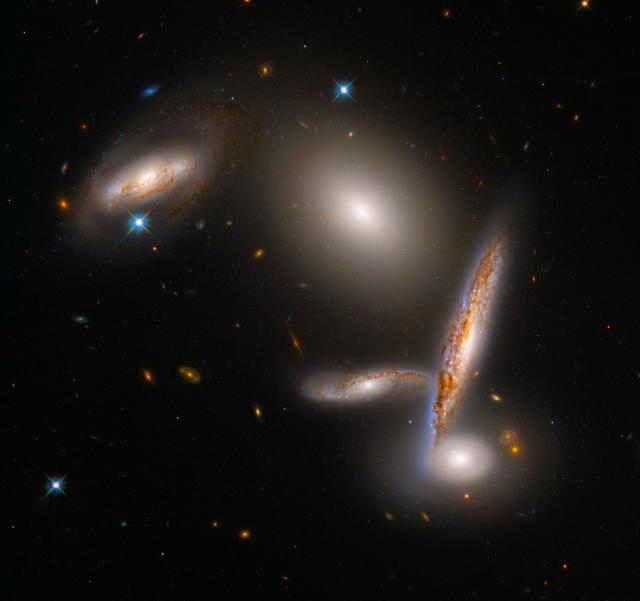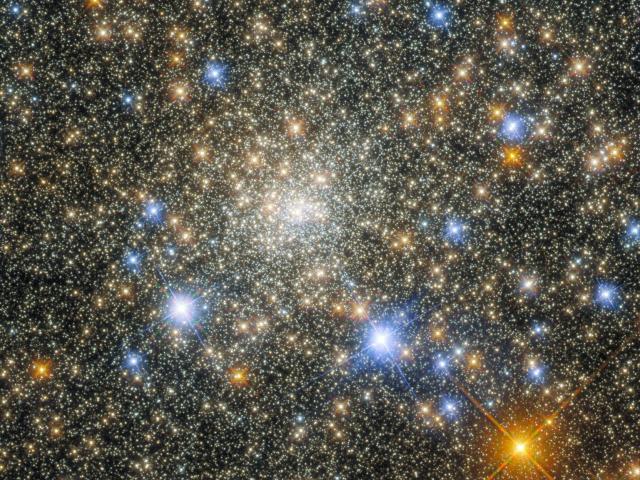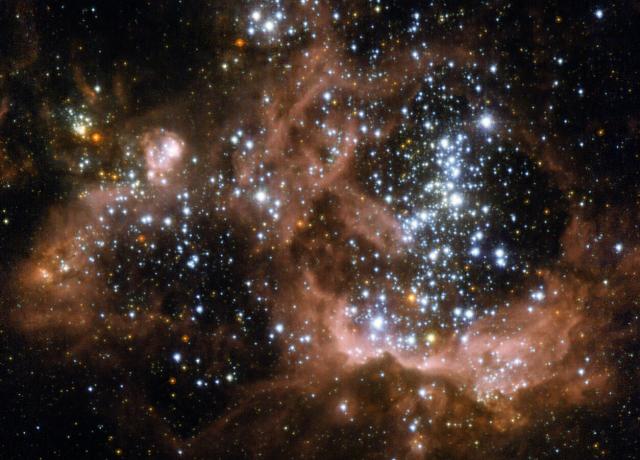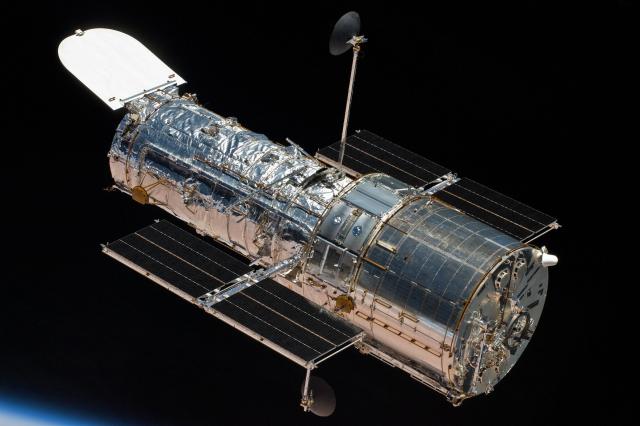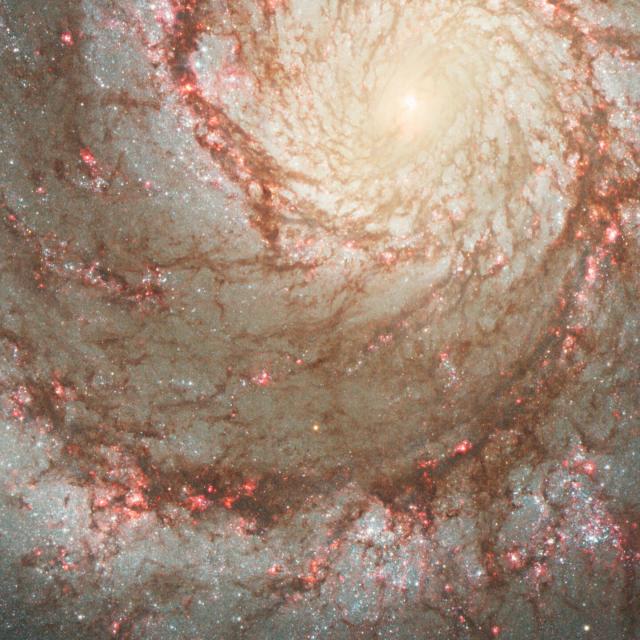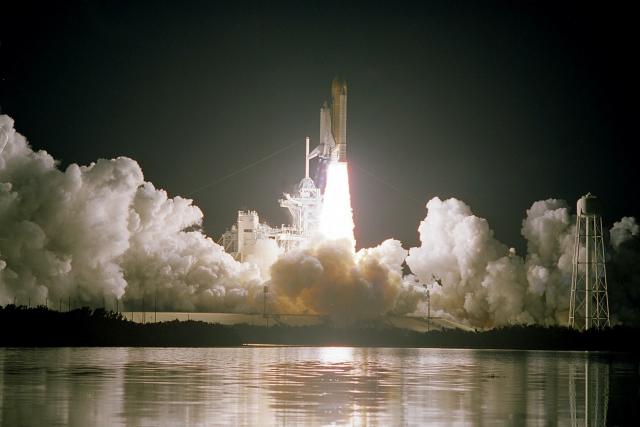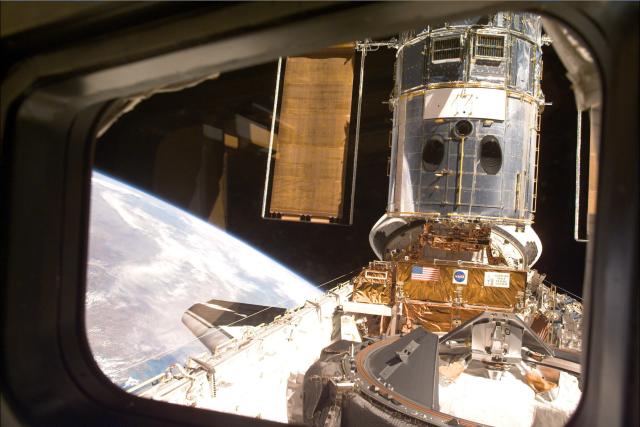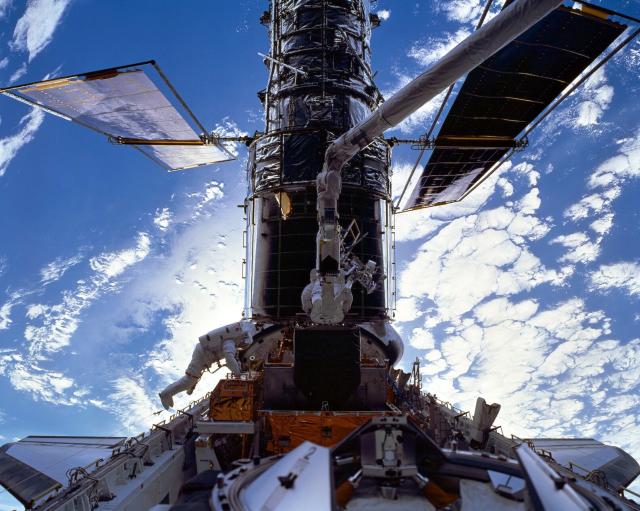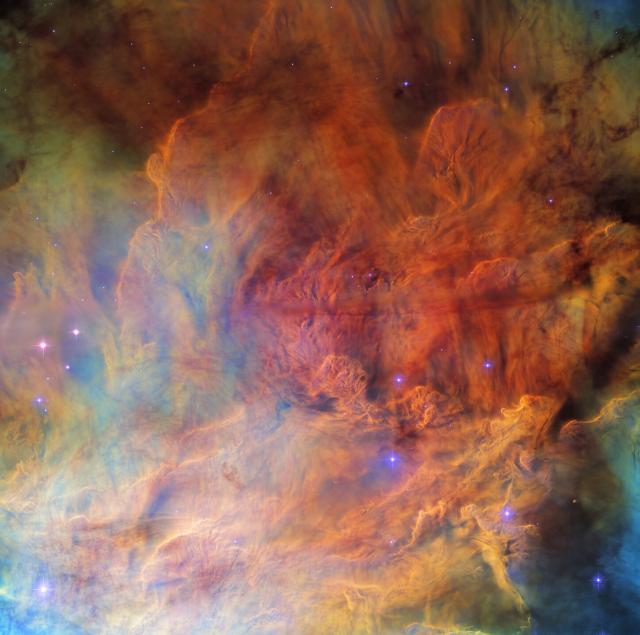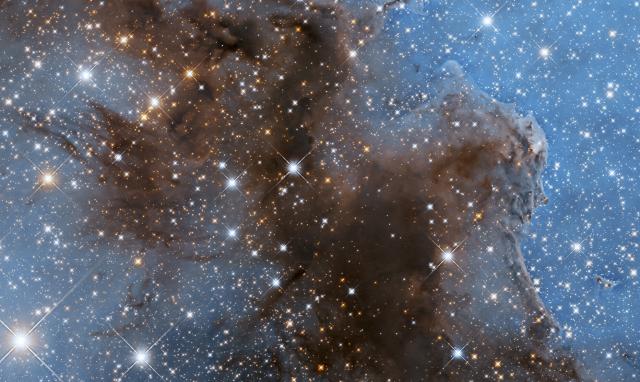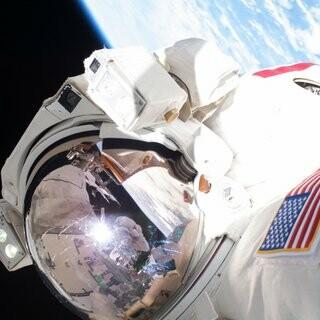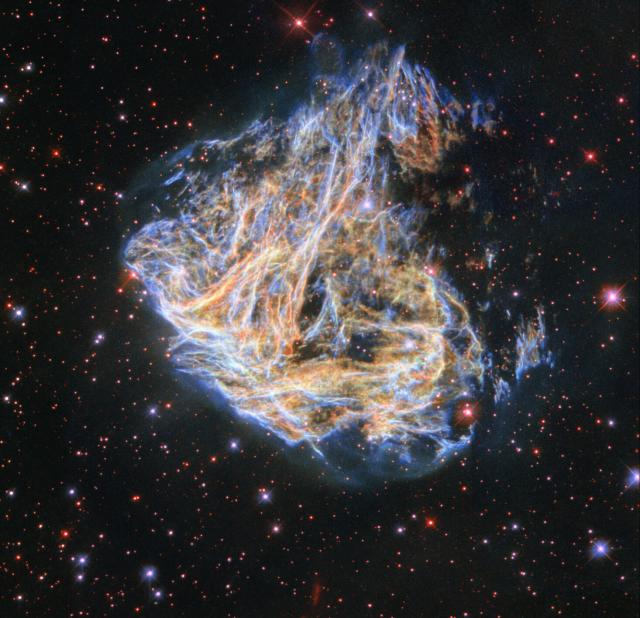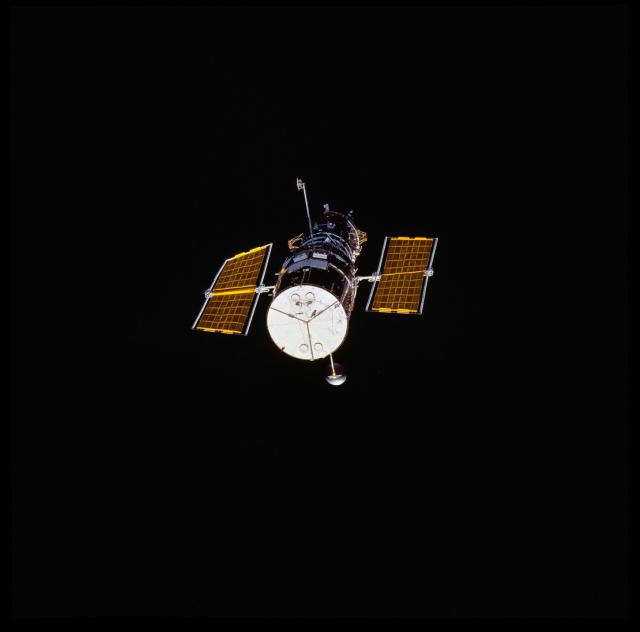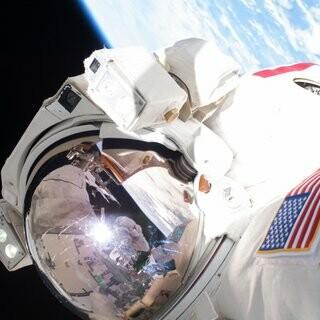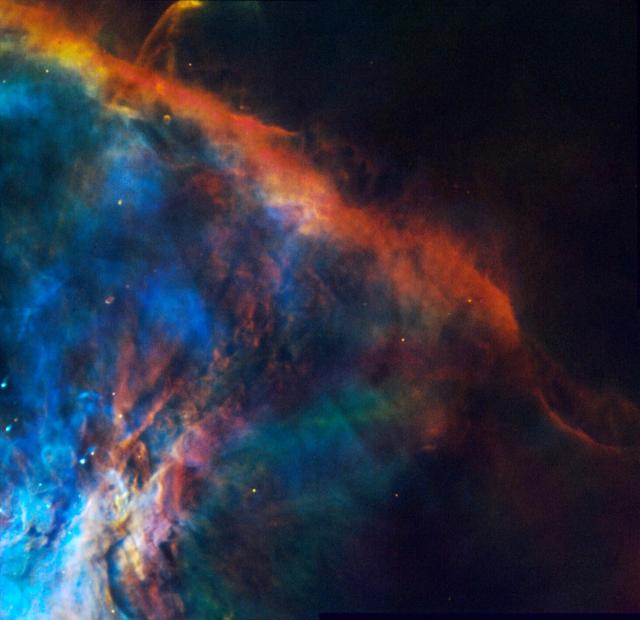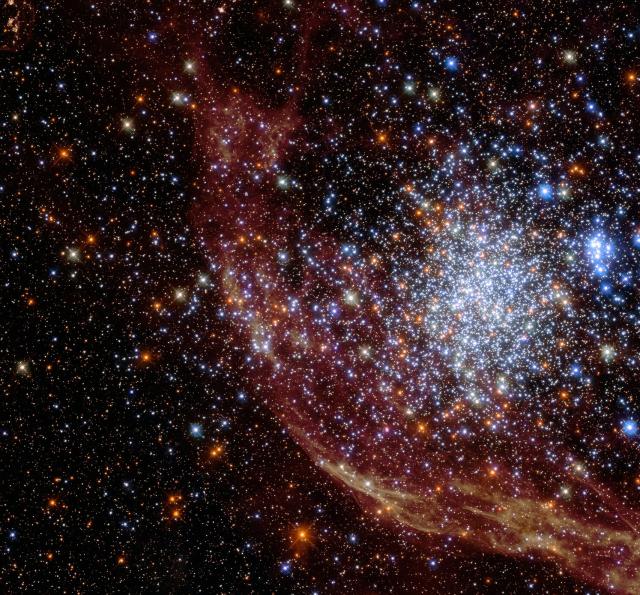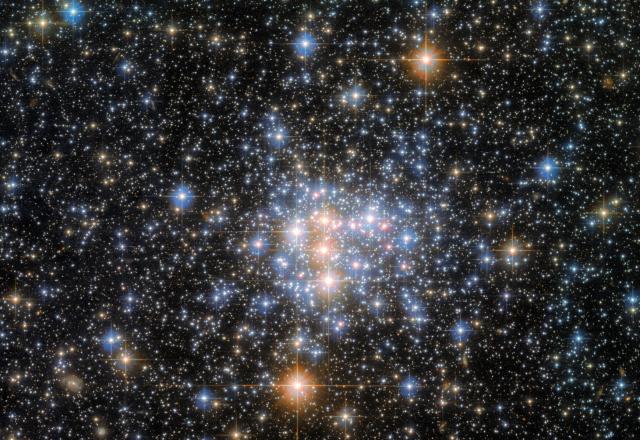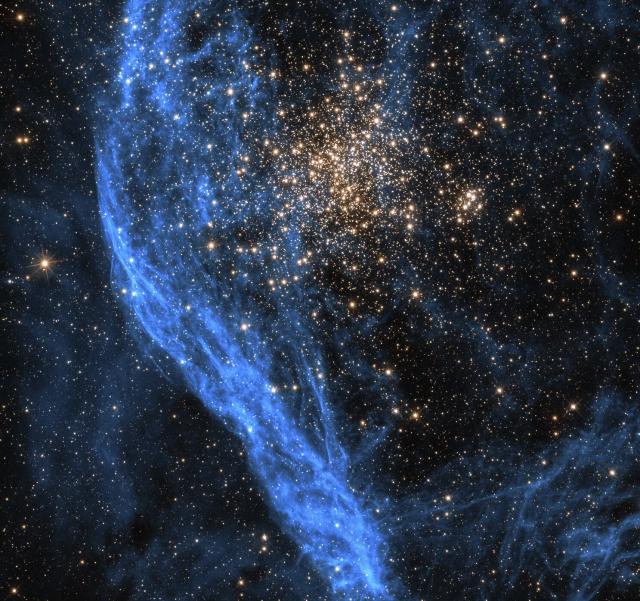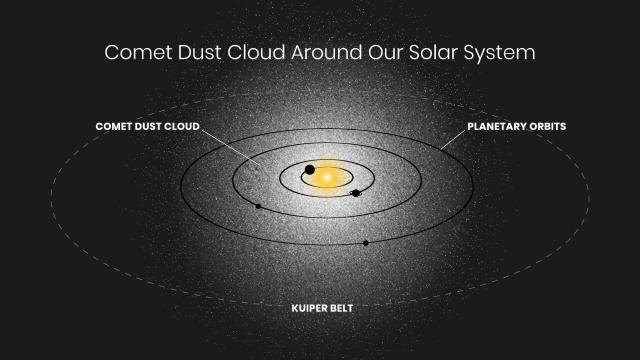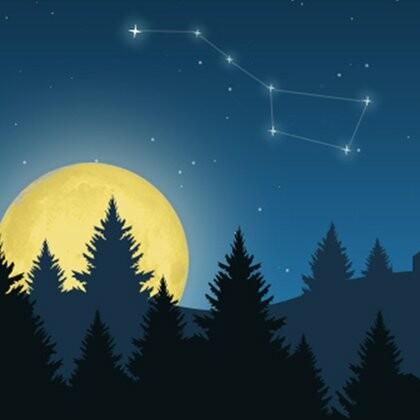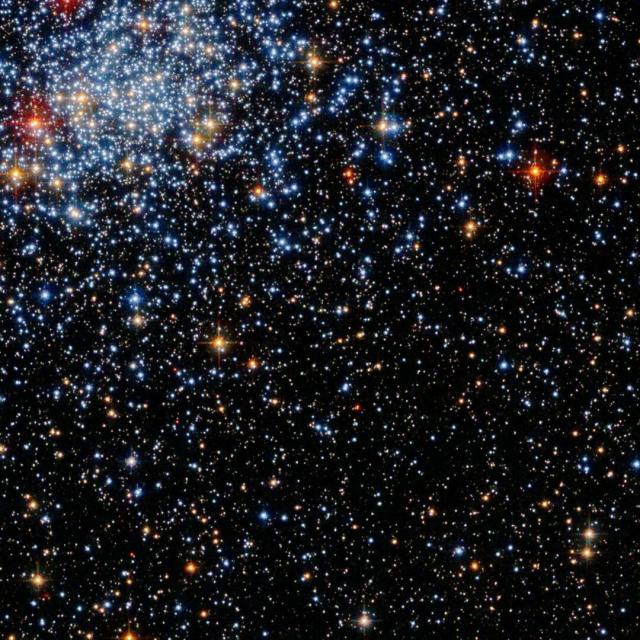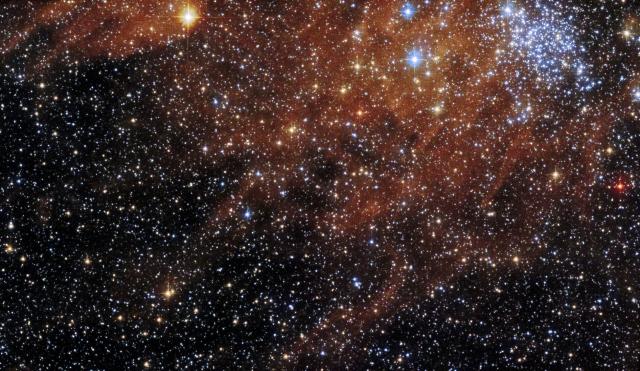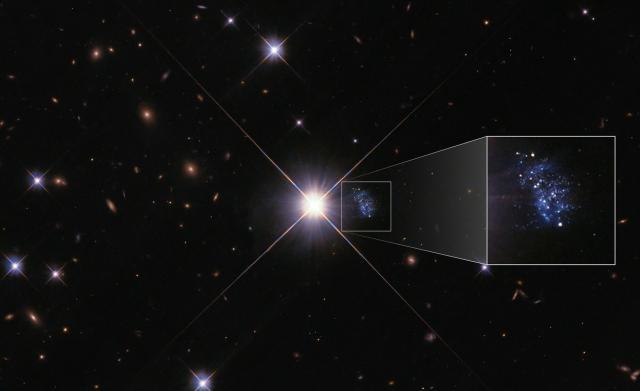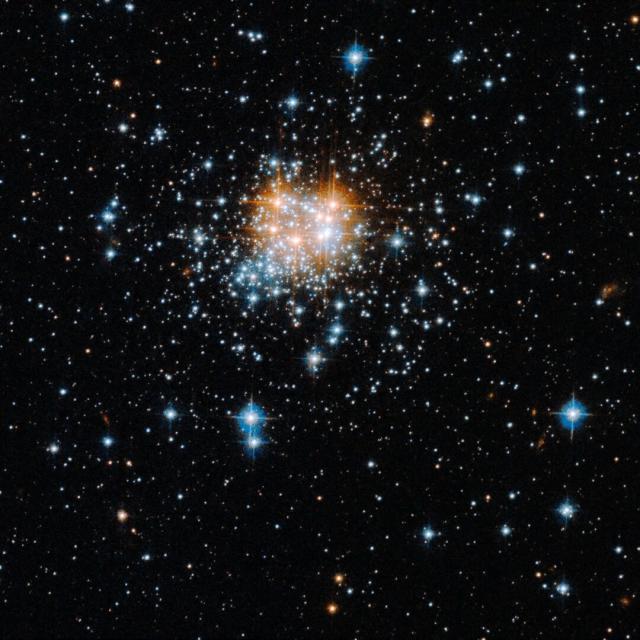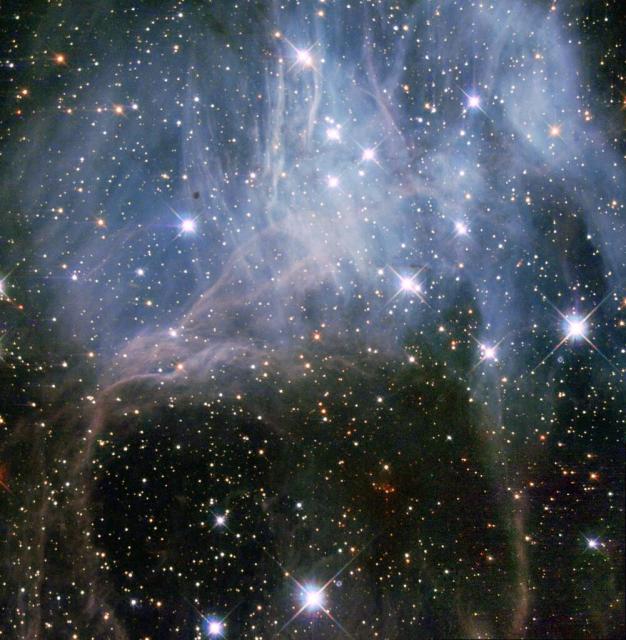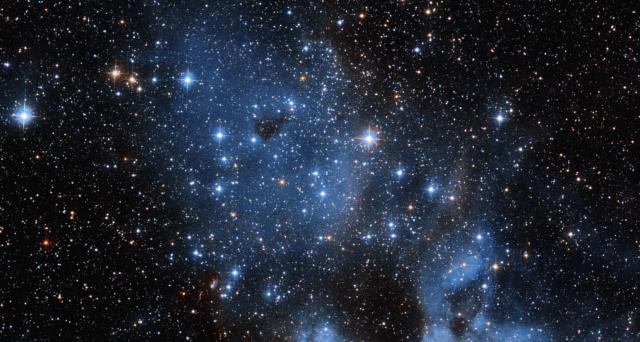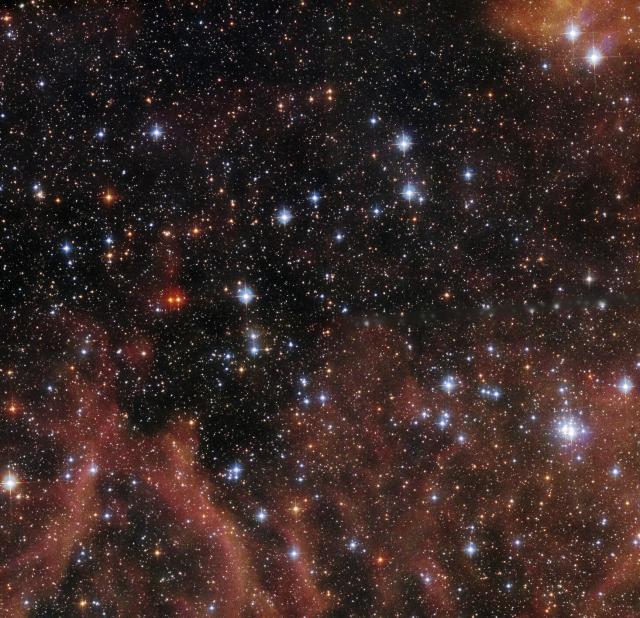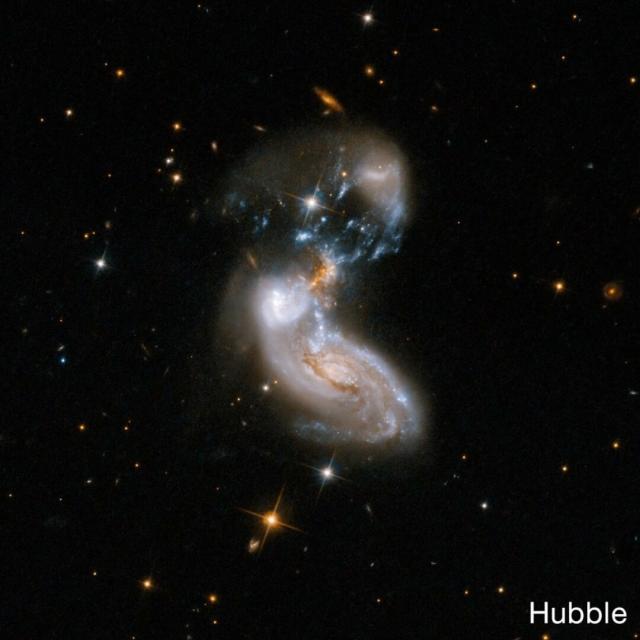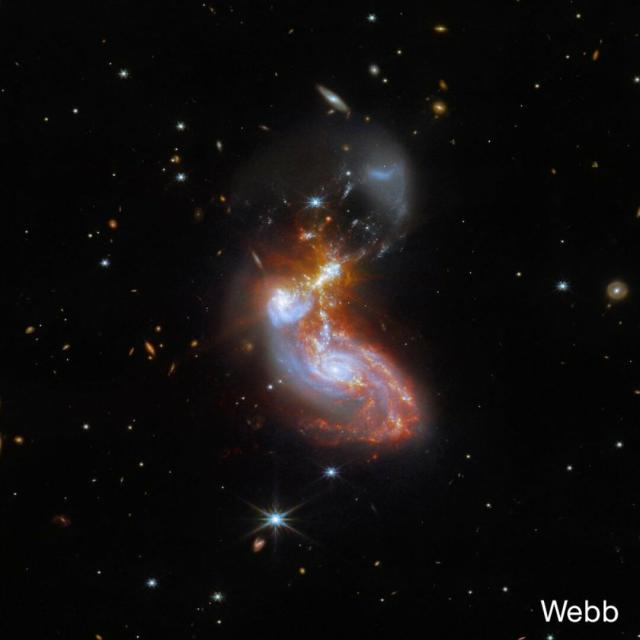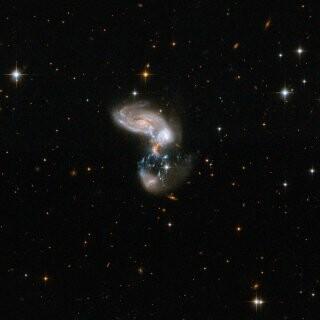Search
Items tagged with: hubble
DEM L 190 looks like #NewYearsEve fireworks! 🎆
This supernova remnant was also voted our Twitter audience's favorite Hubble image from 2022. Good choice!
DEM L 190 is 160,000 light-years away, and made of the debris from a large star's death. For more: go.nasa.gov/3WXpb7p
#Hubble
Hubble Homes in on a Celestial Fireworks Display
Shreds of the colorful supernova remnant DEM L 190 seem to billow across the screen in this image from the NASA/ESA Hubble Space Telescope.Andrea Gianopoulos (NASA)
Look up tonight! All the planets in our solar system are visible (some with the help of a telescope). Check your favorite stargazing site for more info!
Of course, you can look at Hubble’s planet images anytime, like this one of Saturn! For more: go.nasa.gov/3vqF7TI
#Hubble
Hubble's Solar System
The Hubble Space Telescope's view of the planets and other objects orbiting our Sun.NASA Hubble Space Telescope (Flickr)
Happy (almost) New Year!
Before we ring in 2023, we need your help choosing our Twitter audience’s favorite Hubble image released in 2022.
Vote in the poll below, which features the images that got the most likes this year. Then we’ll post the winner on New Year’s Eve!
#Hubble
Welcome to NGC 604, a major star formation center! ⭐
Hundreds of stars are forming in this #HubbleClassic view of a hydrogen cloud 2.7 million years away. It's gradually collapsing due to gravity, forming new stars in the process: go.nasa.gov/3YPS7zR
#Hubble
#Hubble
#HappyHolidays from Hubble!
Here’s a festive sonification of RS Puppis, a glittering star wreathed with dust.
Located about 6,500 light-years away, this star rhythmically brightens and dims over a six-week cycle: go.nasa.gov/3PNSuab
#Hubble
Into the whirlpool! 🌀
Seen in this #HubbleClassic image, the Whirlpool Galaxy's striking spiral arms are star-formation factories; they compress hydrogen gas and create clusters of new stars.
This galaxy is located 31 million light-years away! For more: go.nasa.gov/3YI5JwO
#Hubble
Messier 51 (The Whirlpool Galaxy)
The graceful, winding arms of the majestic spiral galaxy M51 appear like a grand spiral staircase sweeping through space. They are actually long lanes of stars and gas laced with dust.Rob Garner (NASA)
#OTD in 1999: The third servicing mission up to the Hubble Space Telescope launched!
During this mission, astronauts replaced Hubble’s gyroscopes and installed new equipment to make it more capable than before.
Find out more: go.nasa.gov/3W6ohFm
#Hubble
About - Hubble Servicing Missions | SM3A
NASA.gov brings you the latest images, videos and news from America's space agency. Get the latest updates on NASA missions, watch NASA TV live, and learn about our quest to reveal the unknown and benefit all humankind.NASA
This #HubbleFriday view is pretty *stellar*! ⭐
Dive into this spectacular image of a portion of the gigantic Lagoon Nebula. The stars seen throughout are part of the cluster NGC 6530, located about 4,350 light-years away!
For more information: go.nasa.gov/3G7vpfr
#Hubble
Hubble Views a Star-Studded Cosmic Cloud
A portion of the open cluster NGC 6530 appears as a roiling wall of smoke studded with stars in this image from the NASA/ESA Hubble Space Telescope.Andrea Gianopoulos (NASA)
Spectacular spirals 🌀
The star-studded arms of the spiral galaxy NGC 6956 are 214 million light-years away in the constellation Delphinus.
Read more about this new Hubble image: go.nasa.gov/3uQEVgr
#Hubble
Hubble Captures Majestic Barred Spiral
Against an inky black backdrop, the blue swirls of barred spiral galaxy NGC 6956 stand out radiantly.Andrea Gianopoulos (NASA)
Hubble helped find evidence of two exoplanets (planets that orbit stars beyond our Sun) where water makes up a large fraction of the entire planet.
Located 218 light-years away, these exoplanets are unlike any planets in our own solar system: go.nasa.gov/3uUZF6y
#Hubble
Two Exoplanets May Be Mostly Water, NASA'S Hubble and Spitzer Find
A team led by researchers at the University of Montreal has found evidence that two exoplanets orbiting a red dwarf star are "water worlds," where water makes up a large fraction of the entire planet.Andrea Gianopoulos (NASA)
Take a closer look inside the Carina Nebula 👀
Join scientist Dr. Ken Carpenter on a journey through one of the most dynamic regions in the night sky!
For more information: go.nasa.gov/3PsYTHx
#Hubble
Caldwell 92
Astronomers targeted Caldwell 92 to create one of the largest panoramic images ever taken with Hubble’s cameras, generating a stunning 50-light-year-wide view of the tumultuous central region of this strange stellar nursery.Edward Henderson (NASA)
And if you can't get enough Carina, be sure to check out our recently released image featuring a small section of this stunning nebula!
Hubble’s Sparkling New View of the Carina Nebula
This sparkling new image depicts a small section of the Carina Nebula, one of the NASA Hubble Space Telescope’s most-imaged objects.Andrea Gianopoulos (NASA)
A new view of an old favorite!
This sparkling new image depicts a small section of the Carina Nebula, one of Hubble’s most-imaged objects. It’s about 7,500 light-years away, and busy with cosmic activity – including star birth and death!
Read more: go.nasa.gov/3PsWuwv
#Hubble
Hubble’s Sparkling New View of the Carina Nebula
This sparkling new image depicts a small section of the Carina Nebula, one of the NASA Hubble Space Telescope’s most-imaged objects.Andrea Gianopoulos (NASA)
The Carina Nebula is included in the Caldwell Catalog, published in December 1995 – 27 years ago this month!
Stargazer Sir Patrick Moore gathered a list of cosmic targets to encourage fellow amateur astronomers to experience the night sky's wonders.
Explore - The Night Sky | Hubble’s Caldwell Catalog
NASA.gov brings you the latest images, videos and news from America's space agency. Get the latest updates on NASA missions, watch NASA TV live, and learn about our quest to reveal the unknown and benefit all humankind.NASA
Beauty in the chaos 🌟
These colorful shreds of cosmic material are the "leftovers" of a massive star's supernova explosion!
Known as DEM L 190, this bright supernova remnant resides about 160,000 light-years from Earth in the constellation Dorado: go.nasa.gov/3Wi8anN
#Hubble
Hubble Hones in on a Celestial Fireworks Display
Shreds of the colorful supernova remnant DEM L 190 seem to billow across the screen in this image from the NASA/ESA Hubble Space Telescope.Andrea Gianopoulos (NASA)
New scientific instruments were also installed during this mission, which was followed by four more servicing missions using the space shuttle.
Read more about Servicing Mission 1 ⬇️ go.nasa.gov/3FLZYqL
#Hubble
About - Hubble Servicing Missions | SM1
NASA.gov brings you the latest images, videos and news from America's space agency. Get the latest updates on NASA missions, watch NASA TV live, and learn about our quest to reveal the unknown and benefit all humankind.NASA
This #HubbleClassic view taken in 1991 shows a small portion of the Orion Nebula – the image only spans a little over one light-year.
Composed of roiling dust and gas, thousands of stars are forming inside this nebula: go.nasa.gov/3iXXv3y
#Hubble
We heard it’s #MountainDay! ⛰️
“Mystic Mountain” is a spectacular region of starbirth, and one of Hubble’s most iconic pictures.
Take a deeper look inside the image! Read more here: go.nasa.gov/3UFbetf
#Hubble
Hubble Captures View of 'Mystic Mountain'
NASA's Hubble Space Telescope captures the chaotic activity atop a three-light-year-tall pillar of gas and dust that is being eaten away by the brilliant light from nearby bright stars in a tempestuous stellar nursery called the Carina Nebula.NASA Jet Propulsion Laboratory (JPL)
Over the past couple weeks, Hubble explored #StarrySights! ✨
These new Hubble images showcase the beauty, science, and cosmic activity that star clusters contain.
Hungry for more? Check out Hubble's star cluster Flickr album: go.nasa.gov/3UKRPXy
#Hubble
Hubble's Star Clusters
A collection of star clusters imaged by the Hubble Space TelescopeNASA Hubble Space Telescope (Flickr)
Now for the grand #StarrySights finale!
The last image in our star cluster celebration shows NGC 1850, about 160,000 light-years away.
It includes ultraviolet observations, which are ideal for detecting light from the hottest and youngest stars, as seen in this luminous view.
#Hubble
#Hubble
Hubble Captures Dual Views of an Unusual Star Cluster
While these two images may look dazzlingly different, they are actually pictures of the same cosmic object: NGC 1850.Andrea Gianopoulos (NASA)
"Small" but mighty!
Inside the Small Magellanic Cloud, a satellite galaxy to our Milky Way, is the star cluster NGC 376.
Seen in this #HubbleFriday view, NGC 376 is made of stars that are loosely bound together by gravity: go.nasa.gov/3BmGKoN
#StarrySights
#Hubble
Hubble Captures a Glittering Neighbor
This image from the NASA/ESA Hubble Space Telescope captures a small portion of the Small Magellanic Cloud.Andrea Gianopoulos (NASA)
A #StarrySights stunner! 😍
Welcome to NGC 1850, a star cluster about 160,000 light-years away in a satellite galaxy to our own Milky Way, known as the Large Magellanic Cloud.
Read more: go.nasa.gov/3VIoe2u
#Hubble
Hubble Captures Dual Views of an Unusual Star Cluster
While these two images may look dazzlingly different, they are actually pictures of the same cosmic object: NGC 1850.Andrea Gianopoulos (NASA)
Just how dark is dark?
Astronomers studied 200,000 Hubble images and made thousands of measurements to look for any residual background glow in the sky.
The "leftover" light they found was likely caused by sunlight reflecting off of dust from comets: go.nasa.gov/3UHA6Ak
#Hubble
Hubble Detects Ghostly Glow Surrounding Our Solar System
Astronomers sorted through 200,000 Hubble images and made tens of thousands of measurements on them to look for any residual background glow in the sky, in an ambitious project called SKYSURF.Andrea Gianopoulos (NASA)
Time for a Mars “close-up”! 📸
About every 26 months, the orbit of Mars makes its closest approach to Earth – and December 8 is the next time!
This Hubble image shows Mars before its closest approach back in 2016: go.nasa.gov/3iMazJ9
#Hubble
New Hubble Portrait of Mars
Hubble Space Telescope took a photo of Mars on May 12, 2016, when Mars was 50 million miles from Earth, revealing details as small as 20 to 30 miles across.NASA
Stargazers: Tonight Mars will slip behind the Moon for viewers in parts of North America, Europe, and Northern Africa.
This is called a lunar occultation! Check your preferred stargazing app for the time in your area. Learn more ⬇️ go.nasa.gov/3uvBqvN
#Hubble
What’s Up: Skywatching Tips from NASA
Watch the latest video in NASA’s “What’s Up” series to discover the skywatching highlights for this month.NASA Solar System Exploration
Shine bright like NGC 2031 💎
Hubble's next #StarrySights image shows a cluster that resides about 150,000 light-years from Earth in an extremely dense region of the Large Magellanic Cloud, which is a satellite galaxy of our own Milky Way.
For more: go.nasa.gov/3Hgfc8z
#Hubble
Hubble Beholds Brilliant Blue Star Cluster
In the top left corner of this starry sight, the globular cluster NGC 2031 shines brilliantly.Andrea Gianopoulos (NASA)
The latest of our #StarrySights is tucked away in the top right corner of this new Hubble image!
KMHK 1231 is an open star cluster surrounded by plumes of crimson gas and dust where new stars may someday form.
Learn more: go.nasa.gov/3Uzftq3
#Hubble
Hubble Spots Bright Splash of Stars Amid Ripples of Gas and Dust
Open cluster KMHK 1231 is a group of stars loosely bound by gravity. Seen in the upper left of this Hubble Space Telescope image, this cluster in the Large Magellanic Cloud is surrounded by a crimson nebula of gas and dust extending both to the right…Andrea Gianopoulos (NASA)
Peekaboo! 🫣
Hubble helped find a galaxy peeking out from behind the glare of a bright, foreground star. Nicknamed the Peekaboo Galaxy, it's an extraordinary example of a relatively nearby galaxy that shares traits with our universe's earliest galaxies: go.nasa.gov/3F9XIIa
#Hubble
Peekaboo! Tiny, Hidden Galaxy Provides a Peek Into the Past
Peeking out from behind the glare of a bright foreground star, astronomers have uncovered the most extraordinary example yet of a nearby galaxy with characteristics that are more like galaxies in the distant, early universe.Andrea Gianopoulos (NASA)
This inset image highlights the Peekaboo Galaxy, formally known as HIPASS J1131–31.
This galaxy may be the nearest example of the galaxy formation processes that commonly took place not long after the big bang, 13.8 billion years ago.
#Hubble
Let’s go supergiant spotting!
This new #StarrySights image shows NGC 2002, an open star cluster 30 light-years across.
At its center, you can spy red supergiants – massive stars that are fusing helium after exhausting their hydrogen fuel: go.nasa.gov/3isScZs
#Hubble
Hubble Observes an Outstanding Open Cluster
A twinkling group of stars dominates the center of this image. NGC 2002 is an open star cluster that resides roughly 160,000 light-years away from Earth in the Large Magellanic Cloud, a satellite galaxy of our Milky Way containing numerous star-formi…Andrea Gianopoulos (NASA)
Feeling starstruck? 🤩
This Hubble image shows a young star cluster named NGC 2040.
The stars seen here are very loosely clustered, share a common origin, and are drifting together through space! Discover more: go.nasa.gov/3H5xyZB
#Hubble
NGC 2040 in the Large Magellanic Cloud
These bright stars shining through what looks like a haze in the night sky are part of a young stellar grouping in one of the largest known star formation regions of the Large Magellanic Cloud (LMC), a dwarf satellite galaxy of the Milky Way.Flickr
#StarrySights & starry sounds!
This is a data sonification of the star cluster Caldwell 73. Scientists assigned sounds to different aspects of the image for a new way of experiencing the information in it!
Listen to more sonifications: go.nasa.gov/3Vs7IUa
#Hubble
Explore - From Space to Sound
NASA.gov brings you the latest images, videos and news from America's space agency. Get the latest updates on NASA missions, watch NASA TV live, and learn about our quest to reveal the unknown and benefit all humankind.NASA
Our next #StarrySights image shows a cosmic youngster... at a whopping 10 million years old!
NGC 1858 is both an open cluster and an emission nebula. Astronomers believe that star formation within this cluster is ongoing or has very recently occurred: go.nasa.gov/3FnGAjI
#Hubble
Hubble Spies Emission Nebula-Star Cluster Duo
This whole collection is NGC 1858, an open star cluster in the northwest region of the Large Magellanic Cloud, a satellite galaxy of our Milky Way that boasts an abundance of star-forming regions.Andrea Gianopoulos (NASA)
Ready for more #StarrySights? 🌟
This newly released Hubble image shows the open star cluster BSDL 2757. Bright, blue white stars pierce through the rusty-red tones of gas and dust clouds.
Discover more: go.nasa.gov/3VoJNoF
#Hubble
Hubble Views a Cloud-Filled, Starry Scene
Bright, blue-white stars of the open cluster BSDL 2757 pierce through the rusty-red tones of gas and dust clouds in this NASA Hubble Space Telescope image.Andrea Gianopoulos (NASA)
Globular star clusters are beautiful to look at, but what exactly are they?
Find out in this #StarrySights science lesson!
#Hubble
A pair of views of a pair of (merging) galaxies? Yes, please!
Hubble and @NASAWebb have both observed the galactic pair II ZW 96 in different wavelengths of light.
You can learn more about these views here: go.nasa.gov/3GZrPo8
#Hubble
In Hubble’s visible-light view from 2008, the starburst systems that have formed between the two galactic cores with their older stars are clearly seen.
